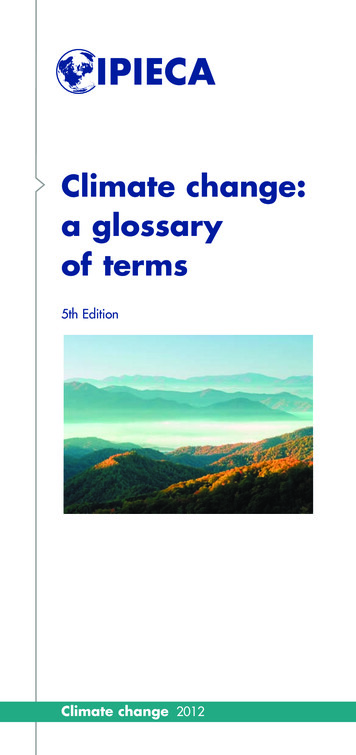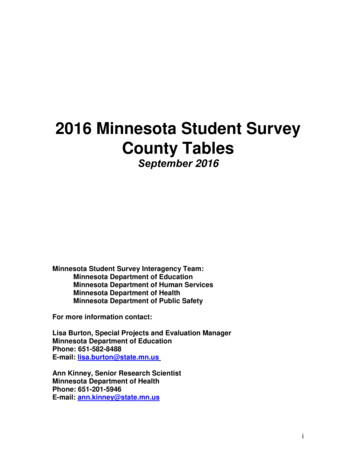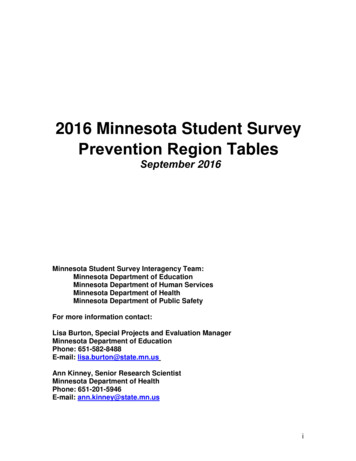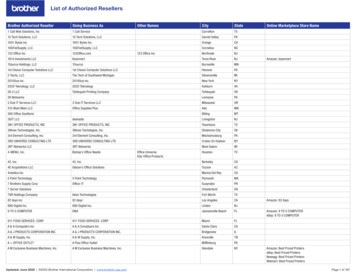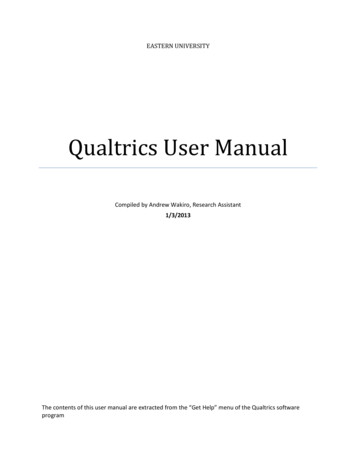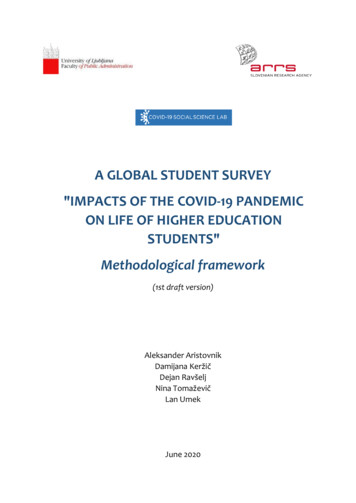
Transcription
A GLOBAL STUDENT SURVEY"IMPACTS OF THE COVID-19 PANDEMICON LIFE OF HIGHER EDUCATIONSTUDENTS"Methodological framework(1st draft version)Aleksander AristovnikDamijana KeržičDejan RavšeljNina TomaževičLan UmekJune 2020
Contents1Introduction . 22Questionnaire Design and Survey Implementation . 33Survey Sample and Methodology . 54Survey Global Partners . 95References .15APPENDIX: The Questionnaire . 16Figure 1: Gender distribution . 7Figure 2: Student status distribution . 7Figure 3: Level of study distrubution . 8Figure 4: Field of study distribution . 8Table 11: Number of responses by country. 61
1 IntroductionIn just few months, the COVID-19 pandemic, caused by the novel coronavirus, has radicallytransformed the lives of people around the globe, including higher education students. Apartfrom the devastating health consequences on people directly affected by the virus, theCOVID-19 pandemic has had major implications for the way higher education students live andwork, affecting their physical and mental well-being in a profound way. To capture theimmediate economic and social effects of this crisis, University of Ljubljana, Faculty of PublicAdministration (with international partners) launched a large-scale online survey across theworld on 5 May 2020. Entitled Impact of the COVID-19 Pandemic on Life of Higher EducationStudents, the online questionnaire targets higher education students - on what student lifelooks like during the COVID-19 pandemic, including teaching and learning, social contacts, aswell as how students are coping with the situation emotionally in different parts of the world.The first part of the survey was ended by 7 June 2020, while the second part started on 8 June2020 and follow-up will run in July/August 2020. The majority of questions are based on “TheEuropean Students’ Union Survey (2020)”, while other questions are new or were adaptedfrom other recent Covid-19 surveys (e.g. Living, working and COVID-19: First findings, 2020). Aglobal comparative analysis will help us to create best recommendations for policymakers andhigher education institutions on how students can be supported in such crises in differentenvironments, such as economic, social, cultural, political and institutional.The questionnaire was opened to any student across the globe, aged 18 and over, andrecruited via announcements at numerous universities and students’ associations world-wide.The survey study was advertised via university communication systems as well as tsandacademicFacebook/Twitter/LinkedIn/Instagram accounts). By 15 June 2020, 30,877 students from sixcontinents, 100 countries and 150 universities took part in the survey. The survey will remainonline over the next few months in order to capture even larger number of students and thefinal results will be presumably published by 30 September 2020.In the following sections, the questionnaire, methodology, survey sample, surveyimplementation and global partners (of the first part) of the survey are described.2
2 Questionnaire Design and Survey ImplementationThe questionnaire titled Impacts of the COVID-19 Pandemic on Life of Higher EducationStudents composed of 39 questions that were divided into 7 sections as follows:1. Socio-demographic and academic characteristics – 8 questions on socio-demographicand academic characteristics of students, e.g. country and institution of study in springsemester, level and field of study, study level, citizenship, age and gender.2. Academic life – 12 questions on how the COVID-19 pandemic affected als/seminars),supervisions/mentorships, assessment and workload, teaching and administrativesupport as well as student performance and expectations.3. Infrastructure and skills for studying from home – 2 questions on conditions to studyfrom home (workspace, equipment, internet connection etc.) and students’ computerskills.4. Social life – 2 questions on students’ support network during the COVID-19 pandemiccrisis and who they would first turn to in different situations.5. Emotional life – 1 question on students' emotions since the outbreak of the COVID-19pandemic.6. General circumstances – 13 questions on worries, financial circumstances, supportmeasures and behaviours.7. General reflections – 1 question on general reflections regarding the COVID-19pandemic.At the end, the respondents had the option to leave their e-mail address in case they wouldlike to receive the results of the survey.The majority of questions based on The European Students’ Union survey (2020) whichtargeted higher education students - on what student life looked like during the COVID-19pandemic. The questions of our survey were partly adjusted and supplemented with selectedelements that enabled the researchers to understand in detail some additional personal andfinancial circumstances as well as the perception of support measures and change ofbehaviour.The questionnaire was at first designed in English – this version of the questionnaire can befound in the Appendix. In the next phase, the international research partners suggestedtranslating it to local languages, so the survey was translated to 6 languages: Italian, NorthMacedonian, Portuguese, Romanian, Spanish and Turkish.3
A set of filters and rooting was applied to the questionnaire in order to adapt thequestionnaire to the particular situation of the respondents, i.e. new questions were offeredin case of cancelation of on-site classes due to a COVID-19 pandemic, in case of paying tuitionfees, receiving a scholarship etc.The online questionnaire was made available to users via 1KA, which is an open sourceapplication that enables services for online surveys free of charge. The development takesplace at the Centre for Social Informatics, at the Faculty of Social Sciences, University ofLjubljana, Slovenia. For data protection reasons the survey was open to people aged 18 orover and presently enrolled in a higher education institution. The participants were alsoinformed on the voluntary and anonymous participation in the study.4
3 Survey Sample and MethodologyBy 15 June 2020, 30,877 students participated in the survey, coming from 129 countries, ofwhich 13,610 (44.08 %) were from Europe, 7,306 (23.66 %) from Asia, 4,220 (13.67 %) from SouthAmerica, 2,708 (8.77 %) from Africa, 2,419 (7.83 %) from North America and 186 (0.60 %) fromOceania. 428 (1.39 %) students didn’t provide the information on the country. The responserate was 34.80 % (30,0877 out of 88,716 who opened the link).The participation was unequally distributed among world countries (Table 1). In particular: 1,000 responses or more were collected in 10 countries (Poland, Mexico, Italy, Chile,Turkey, India, Ecuador, Bangladesh, Portugal, Slovenia); more than 500 but less than 1,000 were collected in 6 countries (Romania, Croatia,Pakistan, Indonesia, Hungary, Ghana); more than 200 and less than 500 were collected in 19 countries; a total of 3,060 responses were collected from 93 countries with less than 200responses.The age of respondents varied from 18 to 70 years with mean age of 23.55 years with standarddeviation of 5.55 years. Most of the respondents belonged to the age group between 20 and24 years (54,86 %, i.e. 12,937 out of 23,582 who reported their age), followed by the age groupunder 20 years (26.88 %) and group between 25 and 30 years (9.84 %). The least frequent groupof students was older than 30 years (8.43 %).The main goal of weighting was to improve the quality and analytic strength of the surveydata. For our purposes, we used post-stratification weights based on combinations ofdemographic characteristics (such as gender, age, level of study, field of study). Forcomparison of different countries and continents (or other geographical areas), we usedpopulation size weights (Bethlehem, n. d., European Social Survey, 2014)5
Table 11: Number of responses by eEgyptUnited Arab EmiratesUnited States ofAmericaSouth AfricaKyrgyzstanGermanyBosnia andHerzegovinaAfghanistanIranNumber ofresponsesProportion 39606876406155405264914674654494384169.3 %6.3 %6.3 %5.8 %5.5 %5.1 %4.8 %4.3 %3.9 %3.4 %3.1 %2.2 %2.1 %2.0 %1.7 %1.7 %1.6 %1.5 %1.5 %1.5 %1.4 %1.3 %3851.2 %3843713681.2 %1.2 %1.2 %3091.0 %2892870.9 %0.9 %70 countries with less than 50 responsesNo country info givenNumber ofresponsesCountryProportion ofresponsesMozambiqueKenyaSpainMaltaSri LankaGeorgiaOmanNew ZealandChinaThailandSlovakiaSaudi ArabiaLibyaKuwaitMalaysiaJordanSerbiaThe 90790.9 %0.9 %0.8 %0.7 %0.7 %0.6 %0.6 %0.6 %0.5 %0.5 %0.5 %0.5 %0.4 %0.4 %0.4 %0.4 %0.4 %0.4 %0.3 %0.3 %0.3 %0.3 %750.2 %TaiwanCyprusUzbekistanGuatemala7472630.2 %0.2 %0.2 %620.2 %Rwanda600.2 %Numberresponses563425of Proportionof responses1.82 %1.38 %6
The figures below show the distribution of basic demographic characteristics of our sample.Missing values are excluded from the plots, i. e. the relative frequencies sum up to 100 %.In our sample, 30,442 respondents answered the question about their gender. Most of themwere female (19,688, i.e. 64.67 %). The percentages for male students (10,375, i.e. 34.08 %) donot sum up to 100 % since 379 students, i.e. 1.24 %, are either gender diverse or preferred notto express their LEFigure 1: Gender distributionIn our sample, 30,350 respondents reported their student status. Most of them were full-timestudents (26,667, i.e. 87.86 %,). The remaining 3,683, i.e. 12,14 % of students were 0%10%12.14%0%FULL-TIMEPART-TIMEFigure 2: Student status distribution7
In our sample, 30,139 respondents reported their level of study. Most of them were abachelor’s degree (1st level) students (24,120, i.e. 80.03 %,), followed by master’s degree (2ndlevel) students (4,575, i.e. 15.18 %). The remaining 1,444, i.e. 4,79 % of students were PhD(doctoral degree (3rd level)) 79%0%BACHELOR’S DEGREE MASTER’S DEGREE DOCTORAL DEGREE(1ST LEVEL)(2ND LEVEL)(3RD LEVEL)Figure 3: Level of study distrubutionIn our sample, 29,785 respondents reported their field of study. Most of them were socialsciences students (11,026, i.e. 37.02 %), followed by a group of applied sciences students(9,258, i.e. 31.08 %) and natural and life sciences students (6,470, i.e. 21.72 %). The leastfrequent group of students was from the field of arts and humanities (3,031, i.e. 10.18 0%APPLIEDSCIENCESARTS AND NATURAL ANDHUMANITIES LIFE SCIENCESSOCIALSCIENCESFigure 4: Field of study distribution8
4 Survey Global PartnersAfghanistanSMART Afghan International Trainings & ConsultancyArgentinaUniversidad Nacional del SurAustraliaWestern Sydney University, School of BusinessBangladeshPatuakhali Science and Technology UniversityBosnia and HerzegovinaUniversity of Sarajevo, School of Economics and Business SarajevoBrazilFederal University of Maranhão - UFMACameroonUniversity of Dschang, Faculty of Medicine and Pharmaceutical SciencesCanadaNova Southeastern university, Northern Alberta Institute of TechnologyChileUniversidad del Bío-BíoChinaChinese Academy of ScienceEducation University of Hong KongHong Kong Polytechnic University, School of NursingNorth China University of Science and TechnologySichuan Agricultural University, College of TourismSouth-Central University for Nationalities, School of EducationWuhan University of Science and TechnologyCongo DRUniversité Protestante au CongoCroatiaUniversity of Rijeka, Faculty of Teacher EducationUniversity of Zagreb, Faculty of Economics and BusinessCyprusCyprus University of Technology, Department of NursingCzech RepublicMasaryk University, Faculty of Economics and AdministrationEcuadorESPOL, Facultad de Ciencias Sociales y HumanísticasEgyptAlexandria University, Faculty of DentistryEthiopiaMekelle University, College of Health SciencesUniversity of Gondar, Department of Human Physiology9
FijiFiji National University, School of Public Health and Primary CareGambiaUniversity of The GambiaGeorgiaEconomics and Business FacultyIlia State University, School of BusinessGermanyCharité – Universitätsmedizin Berlin, Scheffer Center for Medical EducationInstitut für Psychologie, TU DortmundGhanaCentral University CollegeKwame Nkrumah University of Science and TechnologyUniversity of Cape Coast, Department of Population and HealthUniversity of Ghana, Department of SociologyGreeceUniversity of ThessalyUniversity of West AtticaGuatemalaUniversidad de San Carlos de GuatemalaUniversidad Galileo, Facultad de EducaciónHondurasFrancisco Morazán National Pedagogical UniversityHungaryÓbuda University, Keleti Faculty of Business and ManagementIndiaKasturba Medical College, ManipalKing George's Medical University, LucknowMelaka Manipal Medical CollegeNational Institute of Mental Health & NeurosciencesPostgraduate Institute of Medical Education and ResearchSIES College of Management Studies, MumbaiSymbiosis Centre for management Studies (SCMS), NoidaIndonesiaBina Nusantara University (BINUS)IAIN Tulungagung IndonesiaJurusan Keperawatan Poltekkes Kemenkes BanjarmasinPresident UniversityUniveritas Bina Darma , Management Program StudyUniversity of Mataram, Faculty of Mathematics and Natural SciencesIranAhvaz Jundishapur University of Medical SciencesIslamic Azad UniversityResearch Institute Shahid Beheshti University of Medical Sciences10
IsraelCollege of Management Academic Studies, Department of PsychologyKinneret Academic CollegeTel Hai Academic College, Department of PsychologyItalySapienza University of RomeUniversity of Studies "G. d'Annunzio" Chieti – PescaraUniversity of VeronaJapanChuo University, Faculty of LawUniversity of TokyoJordanMiddle East UniversityKenyaCoast Institute of TechnologyKuwaitCollege of Social Science, Department of Information StudiesKuwait University, Department of Educational Administration and PlanningKyrgyzstanUniversity of central Asia, Earth and Environmental SciencesLaosUniversity of Health Sciences, Faculty of Postgraduate StudiesLatviaTuriba UniversityUniversity of Latvia, Faculty of Social SciencesLebanonNotre Dame University-Louaize, Faculty of Natural and Applied SciencesLibyaUniversity of Benghazi, Faculty of Dentistry, Dental Public HealthMalawiUniversity of Malawi, School of Public Health and Family medicineMalaysiaUniversiti Sains Malaysia, School of Pharmaceutical SciencesUniversiti Teknologi MalaysiaUniversiti Utara MalaysiaMaltaL-Universita ta' Malta, Faculty of Health SciencesMexicoCentro de Investigación Biomédica de Michoacán, IMSS,Universidad Autónoma de Chihuahua, Facultad de Filosofía y LetrasUniversidad Autónoma del Estado de Morelos, Faculty of MedicineUniversidad de Guadalajara, Instituto of Astronomía y MeteorologíaUniversidad Iberoamericana PueblaMontenegroUniversity, "Mediterranean" Podgorica, Faculty for Information TechnologyNepalKantipur Dental College Teaching Hospital and Research Center11
New ZealandOtago PolytechnicUniversity of WaikatoNigeriaObafemi Awolowo University, Department of Child Dental HealthRedeemer’s University, Faculty of LawUniversity of Ibadan, College of Medicine, Faculty of Public HealthUniversity of Nigeria, Department of PsychologyNorth MacedoniaHealthgrouper Summit, Health and social policy researchOmanMiddle East College, Computing DepartmentSultan Qaboos UniversityPakistanLahore College for Women UniversityUniversity of Baluchistan, Faculty of Pharmacy & Health SciencesPalestineAl-Quds University, Department of Periodontology and Preventive DentistryPhilippinesCamarines Sur Polytechnic Colleges (CSPC)Cebu Technological UniversityPresident Ramon Magsaysay State UniversityWest Visayas State UniversityPolandCentre for Research and Studies in SociologyGlobal Health and Tropical Medicine, GHTMJagiellonian University Medical CollegeLublin University of Technology, Institute of Computer ScienceMedical University of Lublin, Faculty of Health SciencesPoznan University of Medical SciencesUniversity of Economics in KatowiceUniversity of Rzeszów, Institute of Health SciencesPortugalHigher Institute of Engineering of PortoISPA – Instituto UniversitárioNova University of Lisbon, Faculty of Social and Human Sciences (FCSH)Nova University of Lisbon, Institute of Hygiene and Tropical MedicineUniversity of Aveiro, DEGEITUniversity of Coimbra, Center for Neuroscience and Cell BiologyUniversity of Porto, Computer Science Department12
RomaniaBucharest International High School of InformaticsBucharest University HospitalCarol Davila University of Medicine and PharmacyNational Research Institute for Labour and Social ProtectionUniversitatea Alexandru Ioan CuzaUniversity of Bucharest, Faculty of Sociology and Social WorkUniversity of Medicine and Pharmacy, Faculty of MedicineRussiaInnopolis University, InnopolisOmsk State Technical UniversityRUDN University (Peoples' Friendship University of Russia)Skolkovo Institute of Science and TechnologyRwandaUniversity of Rwanda, College of Science and TechnologySaudi ArabiaImam Abdulrhman Bin Faisal UniversitySerbiaInstitute of Criminological and Sociological ResearchUniversity of Belgrade, Faculty of PharmacyUniversity of Niš, Faculty of EconomicsSlovakiaUniversity of ZilinaSouth AfricaUniversity of Pretoria, Sociology DepartmentUniversity of the WitwatersrandUniversity of ZululandWalter Sisulu UniversitySpainMiguel Hernandez University of Elche, Department of Health PsychologyUniversidad Autónoma de Madrid, School of MedicineUniversidad Miguel HernándezUniversitat Politècnica de ValènciaSri LankaUniversity of Ruhuna, Faculty of Management and FinanceSwedenStockholm University, Department of EducationTanzaniaCollege of Engineering and TechnologyThailandChulalongkorn University, Faculty of Pharmaceutical SciencesKing Mongkut's University of Technology ThonburiMahidol University, Research Institute for Languages and Cultures of AsiaNaresuan University, Faculty of Business Economics and CommunicationsTunisiaSchool of Medicine of Tunis13
Turkeyİstanbul Üniversitesi, Akademik Veri Yönetim SistemiMarmara ÜniversitesiOrdu UniversityUgandaMakerere UniversityUganda National Institute of Public HealthUnited Arab EmiratesMohammed Bin Rashid School of GovernmentUniversity of Sharjah, College of Health SciencesUnited KingdomHuddersfield Business SchoolUniversity of PortsmouthUnited States of AmericaEmory University, Department of BiologyMichigan State UniversityUniversity of Arkansas, College of Education and Health ProfessionsUniversity of Montana, Department of GeographyUniversity of Nevada, College of Business, RenoUzbekistanNational University of UzbekistanVietnamFaculty Council, Scientific UnionZimbabweBindura University of Science Education14
5 References Bethlehem, J. (n.d.). Applied Survey Methods: A statistical Perspective. Weighting.Retrieved from http://www.applied-survey-methods.com/weight.html Eurofound. (2020). Living, working and COVID-19: First findings – April 2020. Dublin:Eurofound. Retrieved eport/2020/living-working-andcovid-19#tab-03 European Social Survey. (2014). Weighting European Social Survey Data. Retrieved fromhttp://www.europeansocialsurvey.org/ The European Students’ Union. (2020). Student Life During the COVID-19 Pandemic.Brussels: The European Students’ Union. tionnaire EuromedSurvey2018.pdffrom15
APPENDIX: The QuestionnaireIMPACTS OF THE COVID-19 PANDEMIC ON LIFE OF HIGHER EDUCATIONSTUDENTSDear Student,University of Ljubljana from Slovenia (with international academic partners) is carrying out the globalsurvey Impacts of the COVID-19 Pandemic on Life of Higher Education Students. The questionnaire isbased on and extending The European Students’ Union survey (2020) and targets higher educationstudents - on what student life looks like during the COVID-19 pandemic, including teaching and learning,social contacts, as well as how students are coping with the situation emotionally.Please, fill in this survey to help us understand the above aspects of your life. The participation in thestudy is voluntary and will help us to create recommendations for policymakers and higher educationinstitutions on how students can be supported in such crises in different environments, such as economic,social, cultural, political and institutional. It should take about 15 minutes to fill in the questionnairedivided to 7 sections. The answers submitted will be anonymous. The collected data will be used just forpurposes of the survey.If you have any further questions please feel free to contact Professor Aleksander Aristovnik, PhD, fromUniversity of Ljubljana: aleksander.aristovnik@fu.uni-lj.si.By clicking on the Next page I hereby certificate that:I was informed on the voluntary and anonymous participation in this study;I am at least 18 years old;I am presently enrolled in a Higher Education Institution.Thank you in advance for participating in this study!16
S1 - SOCIO-DEMOGRAPHIC AND ACADEMIC CHARACTERISTICSIn this part of the questionnaire, we are interested in your socio-demographic and academiccharacteristics.Q1 - In which country do you study (in this tigua & eBeninBhutanBoliviaBosnia &HerzegovinaBotswanaBrazilBruneiBulgariaBurkina FasoBurundiCambodiaCameroonCanadaCape VerdeCentral ongo DemocraticRepublic ofCosta RicaCote d'IvoireCroatiaCubaCyprusCzech RepublicDenmarkDjiboutiDominicaDominican RepublicEcuadorEast TimorEgyptEl SalvadorEquatorial nJordanKazakhstanKenyaKiribatiKorea NorthKorea all onacoMongoliaMontenegroMoroccoMozambiqueMyanmar (Burma)NamibiaNauruNepalThe NetherlandsNew uPalestinian State*PanamaPapua New GuineaParaguayPeruUkraineThe PhilippinesUnited ArabEmiratesPolandUnited KingdomPortugalUnited States VanuatuSt. Kitts & NevisVatican City (HolySt. LuciaSee)St. Vincent & TheVenezuelaGrenadinesVietnamSamoaYemenSan MarinoZambiaSao Tome & PrincipeZimbabweSaudi ArabiaOther:SenegalSerbiaSeychellesSierra LeoneSingaporeSlovakiaSloveniaSolomon IslandsSomaliaSouth AfricaSouth SudanSpainSri aiwanTajikistanTanzaniaThailandTogoTongaTrinidad & TobagoTunisiaTurkeyTurkmenistanTuvaluUganda17
Q2 - Please write the name of your institution (where you study in this semester).(e.g. University of Ljubljana, Faculty of Public Administration)Q3 - Are you a citizen of the country in which you study?YesNoQ4 - What is your student status?Full-timePart-timeQ5 - What level of study you are enrolled in?Bachelor’s degree (1st level)Master’s degree (2nd level)Doctoral degree (3rd level)Q6 - Please indicate your main field of study.Arts and Humanities (History and Archaeology , Languages and Literature, Philosophy, Ethics andReligion.)Social Sciences (Business, Law, Educational Science, Sociology.)Applied Sciences (Civil Engineering and Geodesy, Mechanical Engineering, Sport, Medicine, Health )Natural and Life Sciences (Electrical Engineering, Biotechnical, Pharmacy, Chemistry, Mathematicsand Physics )Other(please specify):Q7 - How old are you (in years)?Q8 - What is your gender?MaleFemaleGender diverseI prefer not to say
S2 - ACADEMIC LIFEIn this part of the questionnaire, we are interested in finding out how the COVID-19 pandemic hasaffected your experiences with teaching and administrative support as well as your performance andexpectations.Q9 - Have your on-site classes (those taking place in the location/campus of your study institution)been cancelled due to the COVID-19 pandemic?No, my on-site classes have not been cancelled.Yes, my on-site classes have been cancelled.Not applicable (e.g. I do not have classes this semester/term).IF Q9 [2] THEN continue Q10 - Q22 ELSE go to S4S21 - LECTURESQ10 – Since on-site classes were cancelled, the organization of lectures has changed. Below, severaldifferent forms of online lectures are listed. Please assess your level of satisfaction with each form. Ifyou have no experience with particular form, please select “Not atisfiedVerysatisfiedNotapplicableOnline in real-time(videoconference)Online with a videorecording (not in realtime)Online with an audiorecording (not in realtime)Online by sendingpresentations tostudentsWritten communication(forums, chat, etc.)Other (please specify) :Q11 - Which of these forms of online lectures has been the most dominant? Please select only one.Online in real-time (videoconference)Online with a video recording (not in real-time)Online with an audio recording (not in real-time)Online by sending presentations to studentsWritten communication (forums, chat, etc.)Other:19
S22 - TUTORIALS/SEMINARS AND PRACTICAL CLASSESQ12 – Since on-site classes were cancelled, the organization of tutorials/seminars and practical classeshas changed. Below, several different forms of online tutorials/seminars and practical classes arelisted. Please assess your level of satisfaction with each form. If you have no experience withparticular form, please select “Not atisfiedVerysatisfiedNotapplicableOnline in real-time(videoconference)Online with a videorecording (not in realtime)Online with an audiorecording (not in realtime)Online by sendingpresentations tostudentsWritten communication(forums, chat, etc.)Other (please specify):Q13 - Which of these forms of online tutorials/seminars and practical classes has been the mostdominant? Please select only one.Online in real-time (videoconference)Online with a video recording (not in real-time)Online with an audio recording (not in real-time)Online by sending presentations to studentsWritten communication (forums, chat, etc.)Other:S23 - SUPERVISIONS/MENTORSHIPSQ14 - Since on-site classes were cancelled, my supervisions/mentorship has been organized (pleaseselect ALL the answers that are true for you). Multiple answers are possible.Via video-callVia voice-callVia e-mail communicationVia texting on social networks (Facebook messenger, Viber, WhatsApp, WeChat, etc.)Not applicable (I had no supervisions/mentorships)Other (please specify):20
Q15 - Which is your preferred method of online supervisions/mentorship? Please select one.Via video-callVia voice-callVia e-mail communicationVia texting on social networks (Facebook messenger, Viber, WhatsApp, WeChat, etc.)Not applicable (I had no supervisions/mentorships)Other (please specify):S24 - ASSESSMENT AND WORKLOADQ16 - Please rate your agreement with the following statements. Since on-site classes were cancelled,my glyagreeNotapplicablehave provided course assignments(e.g. readings, homework,quizzes) on a regular basis.have provided feedback on myperformance on givenassignments.have responded to my questionsin a timely manner.have been open to students’suggestions and adjustments ofonline classes.have informed me on what examswill look like in this new situation.Q17 - On average, compared to the workload before on-site classes were cancelled, would you saythat your study workload over the last weeks has beensignificantly smaller.smaller.the same.larger.significantly larger.S25 - SATISFACTION WITH TEACHING AND ADMINISTRATIVE SUPPORTQ18 - Since on-site classes were cancelled, how satisfied have you been with the organization ofVerydissatisfiedDissatisfied .tutorials/seminars and practicalclasses.supervisions (mentorships).21
Q19 - Since on-site classes were cancelled, how satisfied have you been with support satisfiedNotapplicableteaching staff.technical support or IT services.student affairs office.finance and accounting.international office.library.public relations (websites and socialmedia information).tutors.student counselling services.S26 - STUDENT PERFORMANCE AND EXPECTATIONSQ20 - In view of the new teaching and learning environment, to what extent do you agree w
3 2 Questionnaire Design and Survey Implementation The questionnaire titled Impacts of the COVID-19 Pandemic on Life of Higher Education Students composed of 39 questions that were divided into 7 sections as follows: 1. Socio-demographic and academic characteristics - 8 questions on socio-demographic and academic characteristics of students, e.g. country and institution of study in spring




